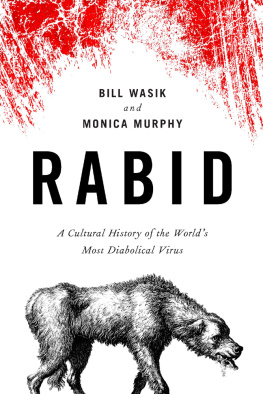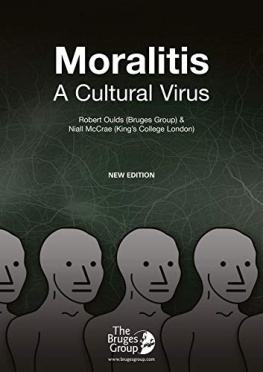RABID

ALSO BY BILL WASIK
And Then Theres This:
How Stories Live and Die in Viral Culture

Frontispiece of a book about a plague in Venice, 1657.
RABID
A CULTURAL HISTORY OF THE
WORLDS MOST DIABOLICAL VIRUS
BILL WASIK AND
MONICA MURPHY
VIKING
VIKING
Published by the Penguin Group
Penguin Group (USA) Inc., 375 Hudson Street, New York, New York 10014, U.S.A. Penguin Group (Canada), 90 Eglinton Avenue East, Suite 700, Toronto, Ontario, Canada M4P 2Y3 (a division of Pearson Penguin Canada Inc.) Penguin Books Ltd, 80 Strand, London WC2R 0RL, England Penguin Ireland, 25 St. Stephens Green, Dublin 2, Ireland (a division of Penguin Books Ltd) Penguin Books Australia Ltd, 250 Camberwell Road, Camberwell, Victoria 3124, Australia (a division of Pearson Australia Group Pty Ltd) Penguin Books India Pvt Ltd, 11 Community Centre, Panchsheel Park, New Delhi110 017, India Penguin Group (NZ), 67 Apollo Drive, Rosedale, Auckland 0632, New Zealand (a division of Pearson New Zealand Ltd) Penguin Books (South Africa) (Pty) Ltd, 24 Sturdee Avenue, Rosebank, Johannesburg 2196, South Africa
Penguin Books Ltd, Registered Offices:
80 Strand, London WC2R 0RL, England
First published in 2012 by Viking Penguin,
a member of Penguin Group (USA) Inc.
10 9 8 7 6 5 4 3 2 1
Copyright Bill Wasik and Monica Murphy, 2012
All rights reserved
Image credits
: Wellcome Library, London; 14: Leeds Museums and Art Galleries (City Museum), UK / The Bridgeman Art Library International; 38 and 202: Photograph by the authors; 64: The Trustees of the British Museum; 90: Private Collection / Peter Newark American Pictures / The Bridgeman Art Library; 118: Bibliothque des Arts dcoratifs, Paris / Archives Charmet / The Bridgeman Art Library; 150: Penguin Group (USA) Inc.; 180: Annals of Internal Medicine; 224: Digital image 2011 Museum Associates / LACMA. Licensed by Art Resource, NY.
Library of Congress Cataloging-in-Publication Data
Wasik, Bill.
Rabid : a cultural history of the worlds most diabolical virus / Bill Wasik and Monica Murphy.
p. cm.
Includes index.
ISBN: 978-1-101-58374-6
1. RabiesEpidemiologyHistory. 2. RabiesTreatmentHistory. I. Murphy, Monica.
II. Title.
RC148.W37 2012
614.563dc23 2011043903
Printed in the United States of America
Set in Haarlemmer with Engravers
Designed by Daniel Lagin
No part of this book may be reproduced, scanned, or distributed in any printed or electronic form without permission. Please do not participate in or encourage piracy of copyrighted materials in violation of the authors rights. Purchase only authorized editions.
ALWAYS LEARNING
PEARSON
For our creaturesEmmett and Mia

From a Spanish edition of Dioscorides De Materia Medica, 1566.
INTRODUCTION
LOOKING
THE DEVIL
IN THE EYE
O urs is a domesticated age. As human civilization has spread itself out over the march of millennia, displacing wildlife as we go, we have found it advisable to strip the animal kingdom of its armies, to decommission its officers. Some of these erstwhile adversaries we have hunted to extinction, or nearly so. Others we relegate to zoos, confine in child-friendly safari parks. The balance we shunt to the margins as we clear the land for ourselveserecting our own sprawling habitats on the ruins of theirs, naming our cul-de-sacs for whatever wilderness we dozed to pave them.
Peer through news reports, though, and one can find pockets of resistance, as if some ancient animal instinct were furtively reasserting itself. Consider the kamikaze bobcat in Cottonwood, Arizona, that set out on a rampage one recent March evening, menacing a worker outside a Pizza Hut and then sauntering into a bar, sending patrons onto the pool table, mauling the one who dared to snap a picture on his phone. Or the frenzied otter in Vero Beach, Florida, at a waterfront golf community called Grand Harbor, that gnawed three residents, one of them while out on the links. Or the enraged beaver in the Loch Raven Reservoir, in the genteel exurban sprawl north of Baltimore, that cruelly interrupted the summertime reverie of four swimmers; it was deterred from devouring them only when the husband of one victim pulled it from her thigh and smashed it with a large rock.
Typically, such wildlife shuns the society of humans. But in an instant we can find these meek woodland creatures transformed into bewilderingly avid attackers, accosting us as we retrieve our mail or walk our dogs. Sometimes they will even attempt a home invasion, as one young couple in the Adirondack hamlet of Lake George, New York, learned on an April evening just a few years ago. Walking from their car, they were set upon by a gray fox; they managed to rush inside their home and close the door. But nearly a half hour later, when they opened the door again, the fox lay in wait; it sprinted toward the opening. Only quick reflexes allowed the young man to close it just as the devils snout broached the threshold. When an animal control officer arrived, the fox attacked his SUV, repeatedly sinking its teeth into the vehicles tires. He shot at it multiple times from out his drivers side window but failed to hit his mark. Later, after the officer had finally run the fox over, he told a reporter that it was the single most aggressive foe he had encountered in nine years on the job. This was a four- or five-pound animal attacking a 3,000-pound vehicle, he said.
The sheer tenacity: that is the truly chilling element in all these tales. What disturbs me, remarked one Connecticut man to the local news, regarding the raccoon he had lately beaten to death with a hammer, is I smashed his mouth off, I smashed his teeth in, but he still wanted to continue in the attack mode. I was actually terrified at the resilience of this animal. In Putnam County, New York, a similarly determined raccoon assaulted one victim at the end of her half-mile-long driveway. She held down the beast while attempting to free her cell phone to call the house; eventually, her husband and son had to club the raccoon repeatedly with a tire iron in order to kill it. (I felt that nature had betrayed me, she later told a reporter for the public-radio show This American Life.) Then there was the red fox in South Carolina that pursued a nine-year-old as he walked to the school bus one morning. After an adult neighbor sheltered the boy, the fox latched on to the Good Samaritans foot. He flung the animal into his home office, where it flailed against the walls and windows before finally falling asleep on a dog bed.
Nearly any species can be afflicted. Arizona officials were recently called to the scene after a dog was attacked by a mad peccary, a piglike creature whose residence in the Southwest had until that point been considered largely peaceable. In Robbins, North Carolina, it was a skunk that beset the pet Pekingese of David Sanders, who was forced to watch the two creatures battle it out for the better part of an hour. In Decatur County, Georgia, a donkey fell prey to the madness and bit its owner on the hand. In Imperial, Nebraska, the afflicted animal was literally a lamb, part of a childs 4-H project gone terribly, almost biblically awry. Some primeval force must truly be at work when the lamb can be made into a lion.












